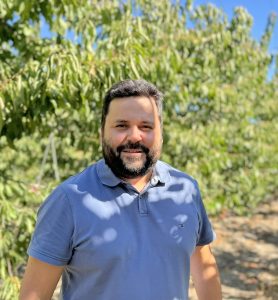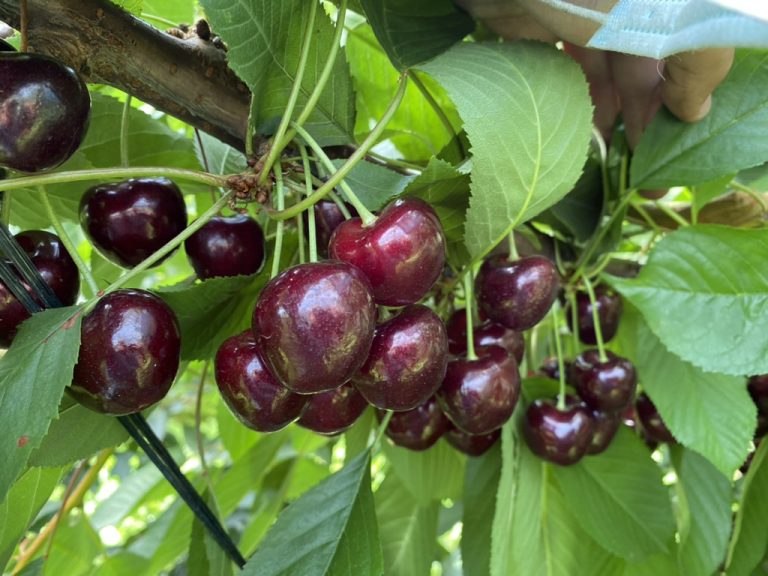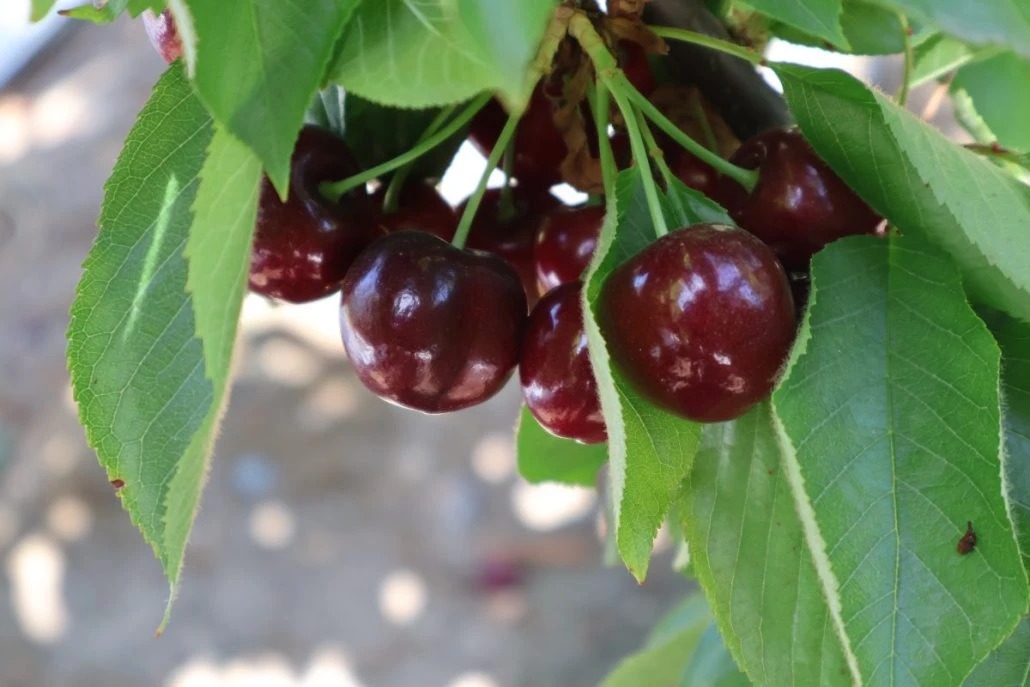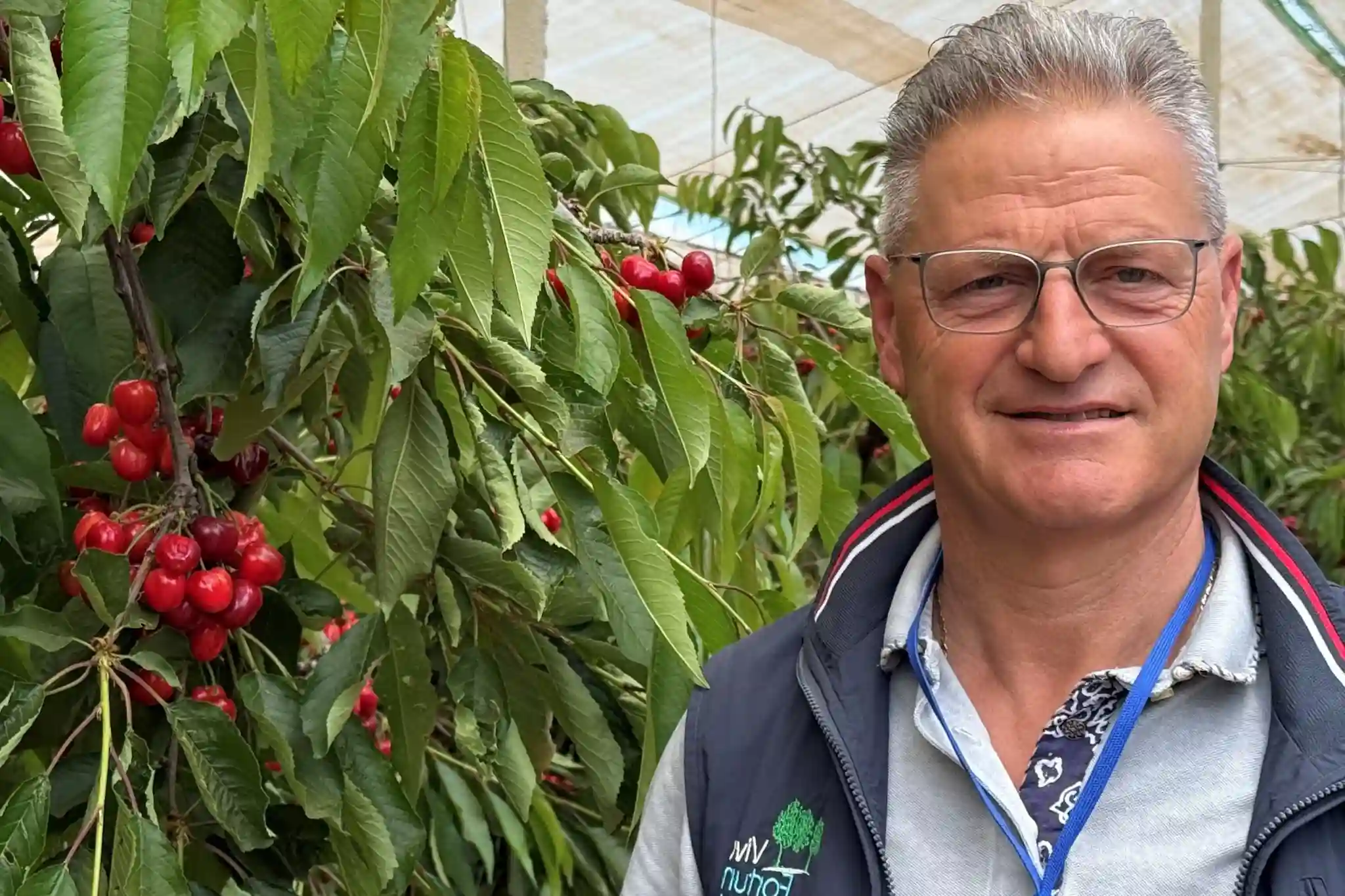Climatic conditions have severely tested the country's main export fruit tree. In the area where the largest national production is concentrated, Santina has borne the brunt; this season, varieties like Lapins and Bing have fared worse. Southern cherry growers, on the other hand, were surprised by yields that in many cases exceeded 20 tons per hectare. A year full of lessons for those who experienced both realities.
Sebastián Navarro, agronomist at PUCV, is a consultant for hazelnuts and cherries in Chillán, south, and a cherry producer at Agrícola San Claudio Ltda. in Chimbarongo, in the O'Higgins region. This "double allegiance" allows him to have a unique perspective on two very different production areas, and he agreed to share his experience in this interview with Redagrícola.
How will this season be remembered?
"In the south, it will be remembered as a very good season. We started with very weak spring temperatures, with very low daytime temperatures. But flowering was very good in 90% of the orchards, reaching production levels that had not been seen for a long time. Most of the growers already in regime produced over 15 tons (t) per hectare (ha)."
"I've heard that in the Osorno area there are even farms that have reached 28 t/ha, although this is not ideal. The group of growers I advise averaged between 17 and 20 t/ha of Regina and Kordia varieties."
Do such high yields affect the size?
"One of the easiest things to achieve in the south is size. The soil conditions, the climate, and the fact that the orchards are covered favor this variable. If in the central zone the focus is on sizes of 2J and up, southern growers, I would say, start from a higher size, that is, 3J. Quality problems are much more associated with firmness, color, and quality, and also with Brix degrees because if they do not reach the required levels, harvesting cannot proceed, so the fruit's firmness is lost."
 Image 1: Sebastián Navarro.What strategy did you use to avoid the impact of the large amount of fruit on quality?
Image 1: Sebastián Navarro.What strategy did you use to avoid the impact of the large amount of fruit on quality?
"Those who realized the situation after load adjustment adopted an enhanced nutrition program with potassium, around 200-300 units (U)/ha. Cherries extract this nutrient in significant quantities. On the other hand, the fruits that end up in good condition correspond to people who have learned to work with nitrogen (N)."
"Some studies show that soils can mineralize up to 300 U/ha in a season. The growers I advised did not apply more than 8 U of N, and this was because the fertilizer used to provide phosphorus has 13% N: it is provided in addition."
Navarro adds some factors to the equation to ensure quality despite a high fruit set. "One of these is to have a good distance between the last production plane and the roof, because 'with the heatwaves we had in January, any fruit firmness abandons you.' It is necessary to maintain a ventilated and well-structured plant," he further specifies.
"Taking these variables into account results in good fruits. I am proud to say that the large sizes are obtained with firmness above 280 firmpro and with soluble solids above 16°Brix."
How do you carry out plant renewal?
"It is difficult to prune in the south without risking infestations. In general, I encourage growers to prune with the orchards already covered, so as not to have free water and gain health. In theory, renewal cuts should be made at the beginning of winter, after September 18, to generate new branches that will bear fruit in two years."
"Given the characteristic vigor of southern plants, light or post-harvest pruning is also very important, as light favors the differentiation process. This is a mandatory practice in the area; ideally, it should be done in the second half of February, before the start of the autumn rains in March."
"During pruning, vigorous vegetative growths (suckers) and poorly positioned branches are removed. Of all the varieties, Regina and Kordia are among those with less acrotonic growth (apical dominance), being more balanced vertically or with a more open habit," says Navarro.
"However, under the plastic canopy, the upper part of the tree tends to exuberance. Formative pruning is the best way to maintain the tree's balance: branching all branches in the same year, they compete equally, making the plant easily assembled and reducing the need for orthopedic work."
"In the south, the normal management is to thin the cherry tree in year 1 to generate the 3-5 basal branches, form the axis, and branch in year 2. This requires a sort of orthopedic work in the first year, but after the branching treatment, many uniformly developed branches are generated."
Dwarfing rootstocks are not enough to solve the problem?
"The Gisela of Osorno is 'another animal': like a Colt with spurs at a young age. Thanks to the soil without physical limitations and the climate, it becomes a six-meter tree. Except for 6-7 days in the season with temperatures above 30°C, maximum temperatures hover around 25°C, the optimal temperature for photosynthesis."
"The only limitations are acidic pH, aluminum saturation, and low base availability. Sunscreens have become fashionable, but I have never seen the need to use them in the south. It is enough that the orchard is well irrigated, well-nourished because a cherry tree in good condition will not have problems with a few days of high heat."
What were the main problems you had to face this year?
"As I mentioned, we had a very cold spring, except for a very warm window between October 10 and 20. Then it rained a lot in November and part of December. Until the third week of November, we had a 70% degree-day deficit compared to the previous year. There was a fear that there would be many abortions, but the plant self-regulated and adapted well."
If they had told you in October that you would have a harvest of 20 t/ha, would you have thinned?
"I have never thinned in the south. In mid-October, with the fruits just born, many people get scared. But Regina generally aborts a lot and the final situation is defined at the end of November, before color break. There may be some structures with a bit of overload, but the kilos are diluted in the average. The only exceptions were emergency cuts in a Lapins block on Gisela to avoid low-caliber fruits."
Does Kordia behave like Regina?
"It is a more juvenile variety than Regina; it is harder to harden and tends to produce much more in branches, so it is important to work on this aspect. In recent years, Kordia from different growers has produced 15-20 t/ha, thanks to the high pollen input from Regina and the assured chill hours in the south."
With Regina's issues, some were considering increasing the amount of Kordia, was this a trend?
"For now, Regina is still the variety of choice in the south. After Kordia comes Regina. It is challenging but has no alternatives. It is a table cherry with a long shelf life, and the local agroclimatic conditions suit it well. Other varieties under study will take at least another five years to validate. Additionally, Regina adapts better to different rootstocks. Kordia is more demanding, but the results are more consistent."
"The projects for the cherry tree have remained on standby in the south. The quality problems of Regina's arrival during the pandemic have obviously affected. It seemed like a tunnel with no way out. However, last year it returned to its usual value: friends from Chillán told me that they were treated like crazy for planting Regina, which in the end was the highest paid. There is already a consensus to sell it and move it quickly to avoid darkening."
"It's not about waiting until it's too dark, but about harvesting it when the color is like Santina's: from 3.5 to 3.8. So, it's still the queen of the south. Kordia tends to overproduce, it's not like in the central zone, there are seasons where it's not enough to be packaged with a premium label, like the cherry for 5-6 dollars that they aspire to."
"However," Navarro adds, "there are projects with 10-15% of their area corresponding to exclusive blocks of Kordia, in order to diversify it and work on it specifically in load regulation or other aspects, because when it acts as a pollinator, both as a row and as isolated plants, it is not possible to treat it differently to express its potential."
"Weather conditions have caused a delay of at least 10 days for most species, including cherry," notes the consultant. "The Regina harvest started on January 15-20 instead of January 7-10, to end in the last week of the month. Kordia is always about a week ahead."
"In the high-load areas, the color was there, but the Brix wasn't reaching, complicating the option of going to sweep the fruits. Some opted for the application of products to even out the color, some with good results, others with inconclusive effects. In general, I wouldn't go as far as to say that there was a greater phenological disparity compared to previous years, considering that there is always a certain degree of heterogeneity in the south, but rather that the entire block was delayed."
"I believe that the harvest was prolonged mainly because of the issue of kilograms: 15 t/ha were expected, but they became 18, 20, 23... some even reached 28. The system starts to jam and you don't get out at the desired moment. Fortunately for the growers who had fruits with good consistency, this allowed them to keep the cherries in the field for a few more days."
As a grower from Chimbarongo, in the O'Higgins region, Sebastián Navarro believes it is a privileged area, thanks to a greater accumulation of cold compared to neighboring areas. However, in the case of Santina, long flowering periods were observed, with poor flowering conditions.
"El Niño rains appeared in that phenological phase and subsequently also with the painted fruit. The result was 6-7 t/ha when the potential was 15 t/ha. Lapins, on the other hand, performed well: 'We worked it for 15 t/ha and got 14,500 kg. Bing also performed well. What struck me is that none of the processing plants were put under pressure by the flow of trucks. One truck was sent out and came back immediately."
"You could see how the zonal workers defended the fruits: if something remained due to lack of color, they asked to keep the fruits even if there were 1,000 kg/ha left. Since in the central zone the heterogeneity was evident, it was very difficult to decide when to enter and whether to sweep or not."
Despite the dispersion of crop maturity, the fruit was of good quality overall, Navarro says. At Agrícola San Claudio, 95% was packaged for export and in the south, he adds, several growers reached 90-95% utilization.
 Image 2.
Image 2.
What are the lessons of the season?
"Spring in the central zone was very similar to what we usually have in the south. When you listen to the strategies of exporting colleagues to defend the productive potential, they are basically what is done every year in Osorno: increasing the number of hives, attractants for bees, pollen in the honeycomb or in exogenous applications, use of ethylene inhibitors to extend flowering and increase pollination chances."
"The biggest difference in any case is given by the extensive use of covers in the south, which improves the microclimatic conditions of the orchard, favoring fruit set, and also reduces the incidence of diseases, frosts, cracks, and allows for applications."
When talking about cracking, Navarro pauses for a moment, recalling how complicated it was to deal with it when a storm front hit the central zone at the end of November.
"It was really atrocious. Despite the precautions, there is always a certain degree of probability. We applied cuticle protectants, calcium chloride. Thanks to the late phenology of Chimbarongo, the cracking was minimal."
The southern experience is also inspiring to face the heavy rains of October-November. The use of sensors, according to Navarro, is important to make decisions about the timing and frequency of irrigation in case of unstable sources. Some did not irrigate to avoid cold ground, others got nervous and did it.
What was the good irrigation management in the north in the circumstances described?
"The industry in general is accustomed to long irrigations and filling the pond on every occasion. This season the pond was full until the second half of November, so irrigating a lot meant staying in the condition of spring fever, of a poorly active root."
"Consequently, water supply had to be very controlled until that date. The forecasts associated with 'El Niño Godzilla' turned out to be quite accurate," he continues, "so he advises to keep them in mind and to pay attention to information on how the season will be."
"Summer in the central zone required the use of sunscreen and the application of algae to cope with radiation stress and heat waves. Navarro also suggests considering the application of some microorganisms at the root and leaf level, depending on the particular conditions."
"If we're told that autumn will be warm, we should take precautions in anticipation of a possible lack of cold, acclimating the plant to favor a good recession entry."
Could you illustrate a strategy for a warm autumn?
"The first thing to do is to manage irrigation well to avoid the plant regrowing or defoliating too early. My management line involves a gradual reduction in irrigation. It's not about cutting off water on March 15 because autumn is around the corner, unless there is significant rainfall and it is seen that the plant extraction decreases."
"On the other hand, later on, you can resort to molybdenum-based products to help the plant if the breakdown is delayed. Set a deadline to intervene if the plant hasn't entered dormancy. Low temperatures are a determining factor in this process; if the plant doesn't arrive before May 10 with clear leaf senescence (yellow leaves), even with reduced irrigation and product application, the leaves must be artificially discarded."
"In the south, it wasn't necessary to apply molybdenum, but we pruned and uncovered the roofs to expose the plant to cold as the most important factor for the plant's recession entry."
Source: Redagrícola
Images: Redagrícola
Cherry Times - All rights reserved














